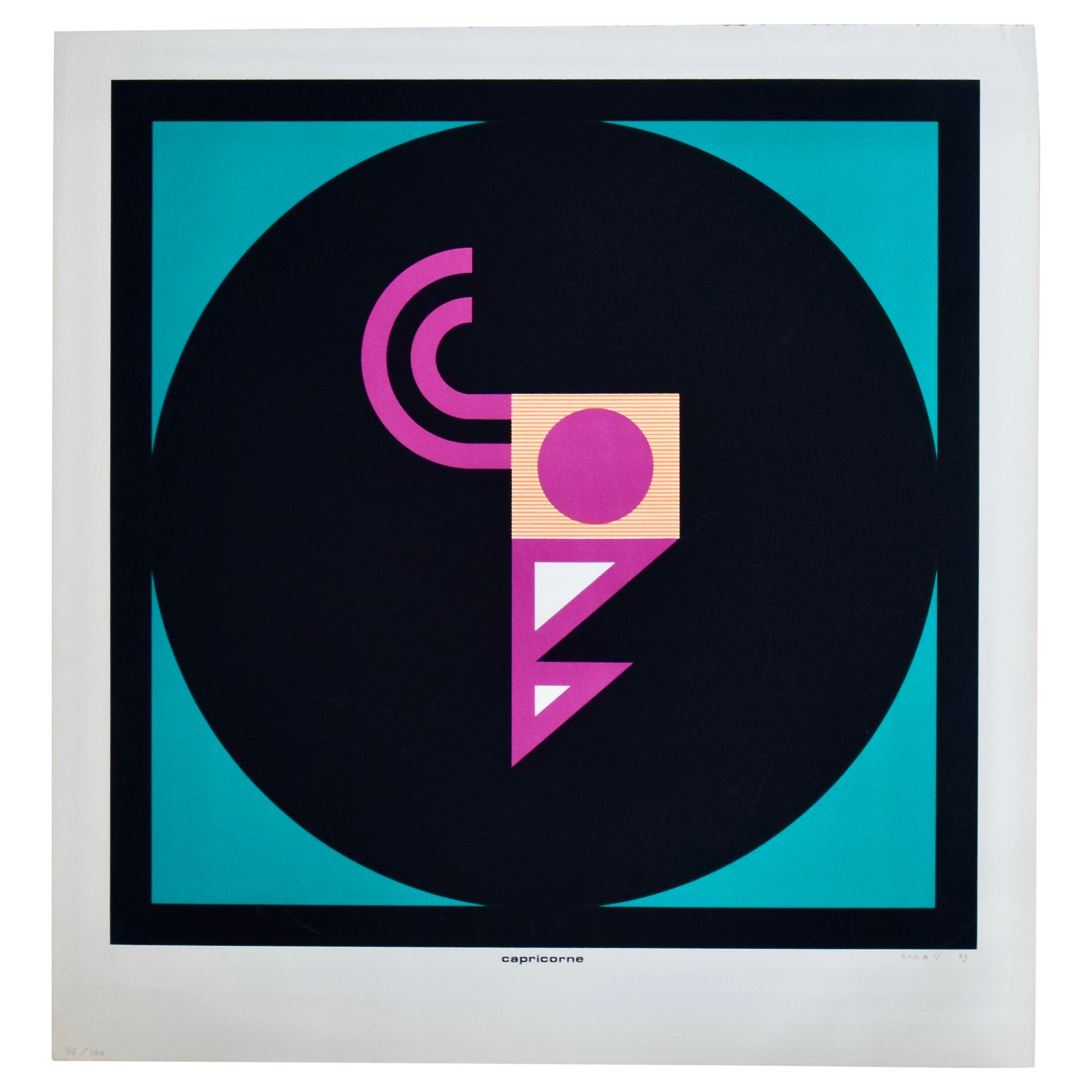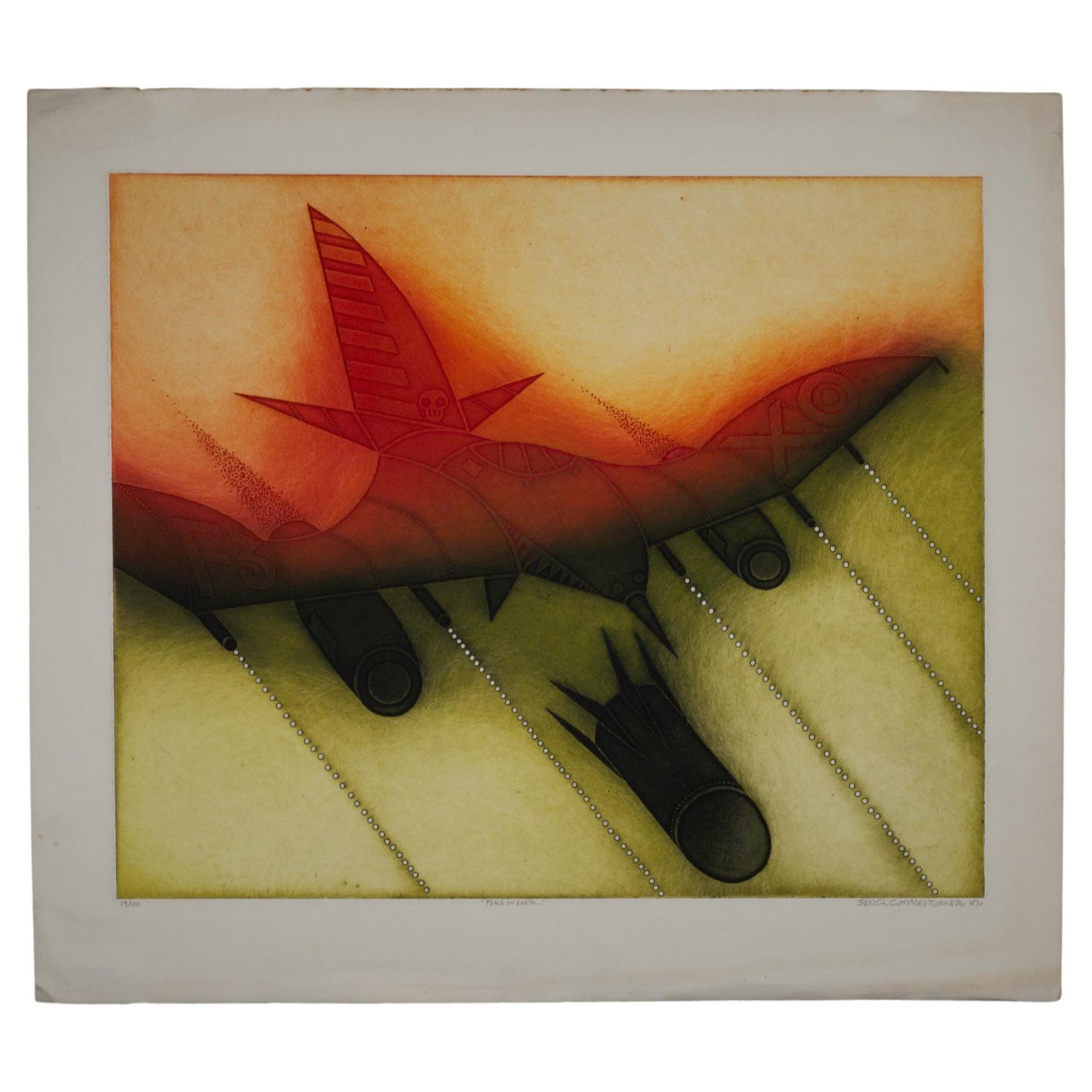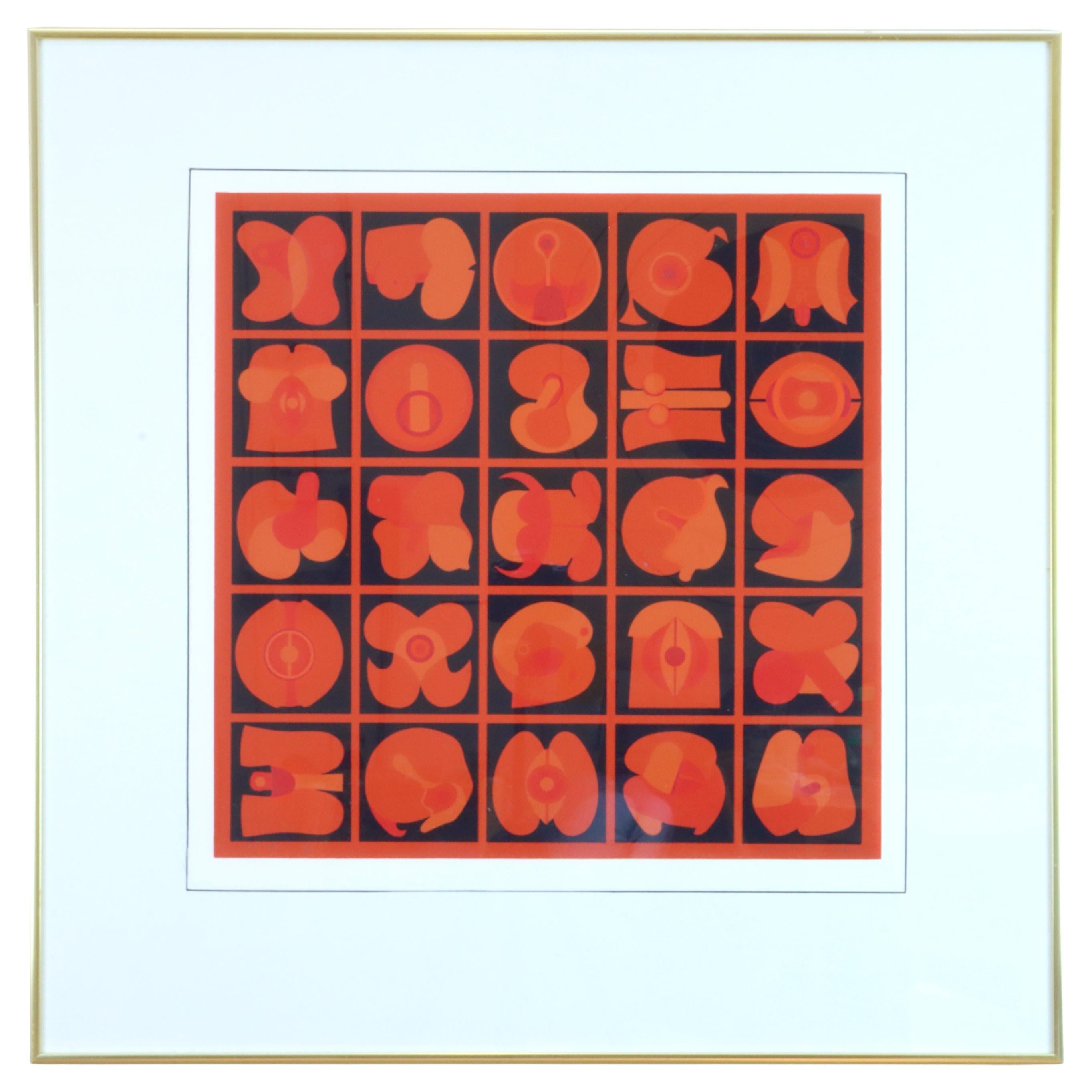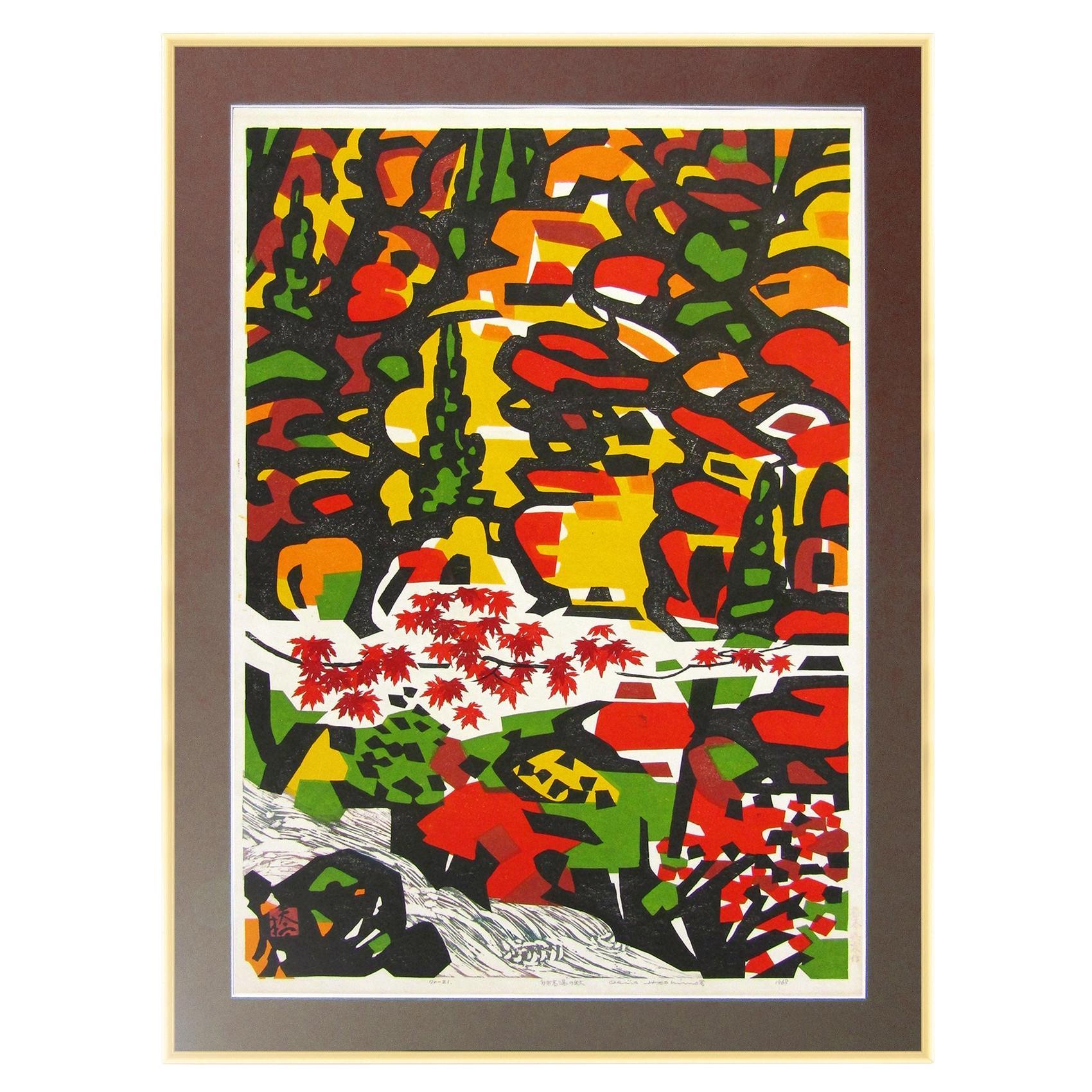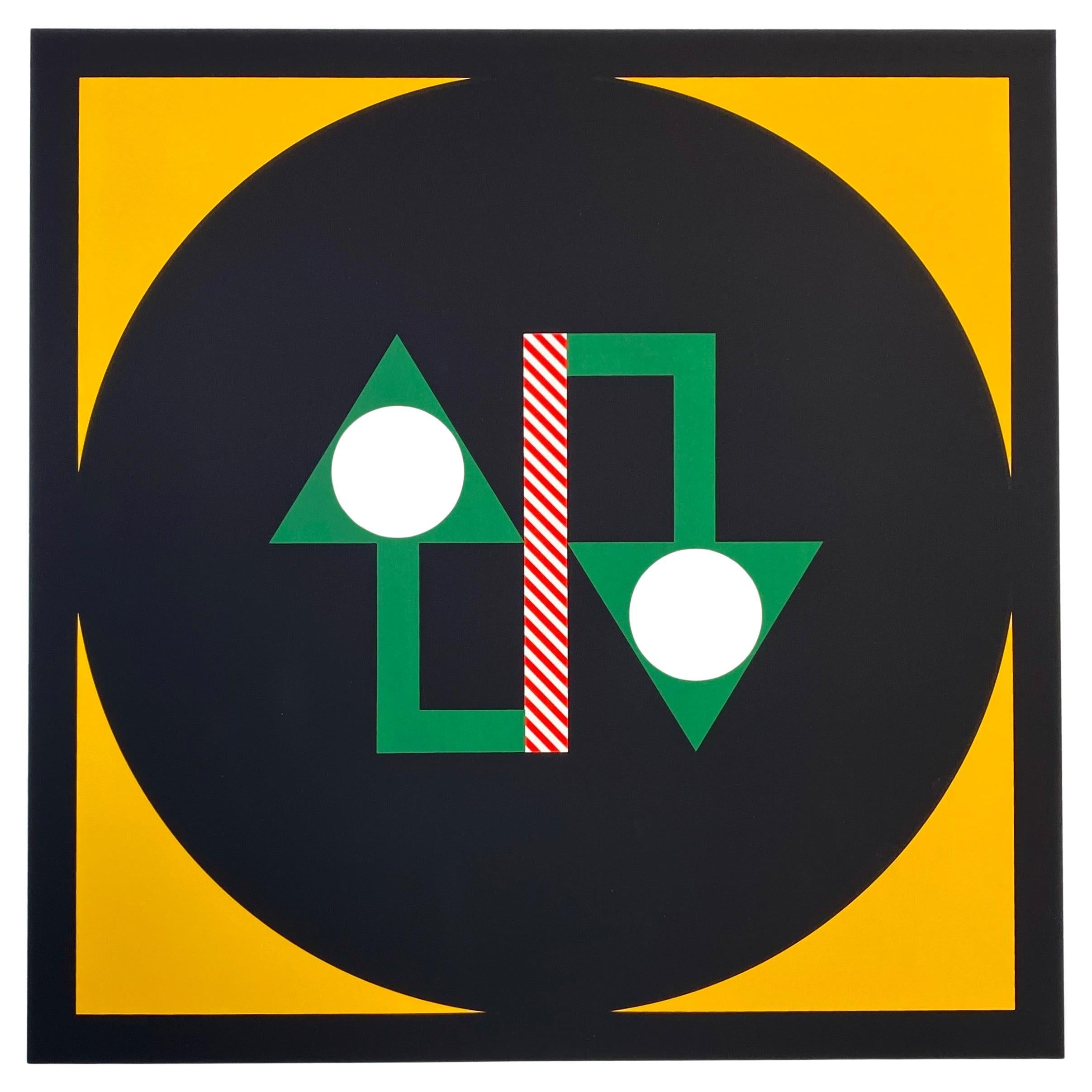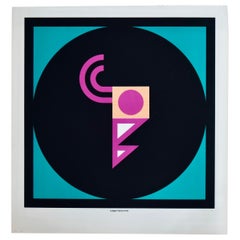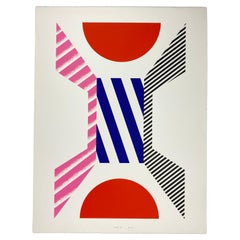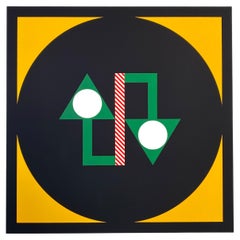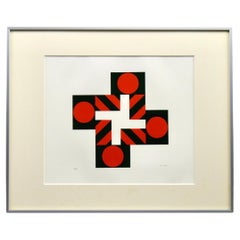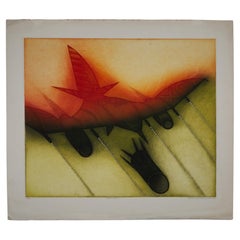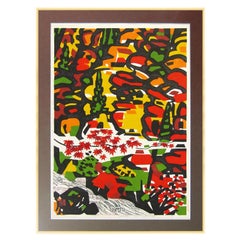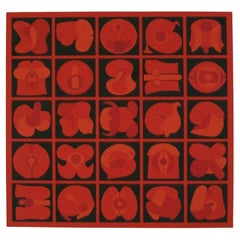Items Similar to 1960, Silk Screen Print "Peace One" by Reiko Momiyame, Japan
Want more images or videos?
Request additional images or videos from the seller
1 of 9
1960, Silk Screen Print "Peace One" by Reiko Momiyame, Japan
$1,122.38
£841.29
€950
CA$1,541.96
A$1,721.45
CHF 902.02
MX$21,072.27
NOK 11,455.60
SEK 10,801.18
DKK 7,231.75
About the Item
"Peace One" by Reiko Momiyame.
A rare and beautiful Pop Art period silk screen print signed in pencil by the artist.
The print is in great condition with strong bright vibrant colors of the period.
Pop art is an art movement that emerged in the United Kingdom and the United States during the mid- to late-1950s. The movement presented a challenge to traditions of fine art by including imagery from popular and mass culture, such as advertising, comic books and mundane mass-produced objects. One of its aims is to use images of popular culture in art, emphasizing the banal or kitschy elements of any culture, most often through the use of irony. It is also associated with the artists' use of mechanical means of reproduction or rendering techniques. In pop art, material is sometimes visually removed from its known context, isolated, or combined with unrelated material.
Amongst the early artists that shaped the pop art movement were Eduardo Paolozzi and Richard Hamilton in Britain, and Larry Rivers, Ray Johnson. Robert Rauschenberg and Jasper Johns among others in the United States. Pop art is widely interpreted as a reaction to the then-dominant ideas of abstract expressionism, as well as an expansion of those ideas. Due to its utilization of found objects and images, it is similar to Dada. Pop art and minimalism are considered to be art movements that precede postmodern art, or are some of the earliest examples of postmodern art themselves.
Pop art often takes imagery that is currently in use in advertising. Product labeling and logos figure prominently in the imagery chosen by pop artists, seen in the labels of Campbell's Soup Cans, by Andy Warhol. Even the labeling on the outside of a shipping box containing food items for retail has been used as subject matter in pop art, as demonstrated by Warhol's Campbell's Tomato Juice Box, 1964
- Dimensions:Height: 16.42 in (41.7 cm)Width: 14.69 in (37.3 cm)Depth: 0.01 in (0.2 mm)
- Style:Mid-Century Modern (Of the Period)
- Materials and Techniques:
- Place of Origin:
- Period:
- Date of Manufacture:1960
- Condition:Wear consistent with age and use.
- Seller Location:Weesp, NL
- Reference Number:1stDibs: LU1464232609402
About the Seller
5.0
Gold Seller
Premium sellers maintaining a 4.3+ rating and 24-hour response times
Established in 1996
1stDibs seller since 2015
374 sales on 1stDibs
Typical response time: <1 hour
- ShippingRetrieving quote...Shipping from: Weesp, Netherlands
- Return Policy
Authenticity Guarantee
In the unlikely event there’s an issue with an item’s authenticity, contact us within 1 year for a full refund. DetailsMoney-Back Guarantee
If your item is not as described, is damaged in transit, or does not arrive, contact us within 7 days for a full refund. Details24-Hour Cancellation
You have a 24-hour grace period in which to reconsider your purchase, with no questions asked.Vetted Professional Sellers
Our world-class sellers must adhere to strict standards for service and quality, maintaining the integrity of our listings.Price-Match Guarantee
If you find that a seller listed the same item for a lower price elsewhere, we’ll match it.Trusted Global Delivery
Our best-in-class carrier network provides specialized shipping options worldwide, including custom delivery.More From This Seller
View AllKumi Sugaï Limited Edition Silkscreen Print Capricorn 1973
By Kumi Sugai
Located in Weesp, NL
Kumi Sugaï, one of the most internationally acclaimed Japanese painters of the twentieth century.
Kumi Sugaï Capricorne, Capricornus, 1973 limited edition silkscreen print. 50 x 53 ...
Category
Vintage 1970s Japanese Mid-Century Modern Prints
Materials
Paper
1970 lithograph titled ‘Fête’ by Kumi Sugaï 92/100
By Kumi Sugai
Located in Weesp, NL
Kumi Sugai, Fête, 1970 – Signed & Numbered Lithograph (Edition 92/100)
Dimensions: H 65 x W 50 cm 25.6 x 19.7 in
A striking example of post-war Japanese modernism, Fête (1970) by ...
Category
Vintage 1970s Japanese Modern Prints
Materials
Paper
Kumi Sugaï 1973 Limited Edition "Balance" Lithograph
By Kumi Sugai
Located in Weesp, NL
Embrace the harmonious blend of traditional Japanese aesthetics and modern abstraction with this striking limited edition lithograph, "Balance" by the renowned artist Kumi Sugaï. Cre...
Category
Vintage 1970s French Mid-Century Modern Prints
Materials
Paper
Kumi Sugaï, “Crossing 4”, 1978 — Signed & Numbered Silkscreen
By Kumi Sugai
Located in Weesp, NL
Kumi Sugaï, “Crossing 4”, 1978 — Signed & Numbered Silkscreen Printed by Ryoichi Ishida Studio
Offered here is a striking limited edition silkscreen by renowned Japanese-French artist Kumi Sugaï (1919–1996), titled “Crossing 4”, created in 1978. Known for his refined visual language merging Zen philosophy, Japanese calligraphy, and European modernism, Sugaï’s work resonates with clarity, movement, and meditative strength.
This particular work was printed by the prestigious Ryoichi Ishida printing company in Tokyo, a studio celebrated for its collaborations with contemporary masters including Andy Warhol. The print is hand-signed and numbered by the artist in pencil, marked 237/250, and was originally sold by Sarani Gallery in Tokyo in 1978 or 1979.
Title: Crossing 4
Date: 1978
Medium: Silkscreen on paper
Edition: 237/250, signed and numbered in pencil
Printer: Ryoichi Ishida Studio, Tokyo
Provenance: Sarani Gallery, Tokyo
Sheet size (unframed): 18 x 18 cm / 7.1 x 7.1 in
Condition: Excellent vintage condition, vibrant colors and sharp impression
Sugaï’s works are part of major international collections, including MoMA (New York), the Centre Pompidou (Paris), and The National Museum of Modern Art (Tokyo). His “Crossing” series is particularly admired for its rhythmic balance of form and color—embodying motion, intersection, and harmony.
This is a rare opportunity to acquire a signed print by a postwar master who bridged Eastern minimalism and Western abstraction, produced by one of the most respected printing studios of the 20th century.
Price includes frame. The Art will be shipped insured overseas in a custom made wooden case. Transport to the US, Euro 275, is case included.
Kumi Sugaï, one of the most internationally acclaimed Japanese painters of the twentieth century.
Colors may slightly vary due to photographic lighting sources or your monitor settings.
KUMI SUGAÏ, JAPAN (1919 - 1996)
Kumi Sugaï was a painter, sculptor and print maker born in 1919 in Kobe, Japan. Sugaï first experimented with oil painting at age nine and became a student at the Osaka School of Fine Arts in 1933 when he was fourteen. He met with the Gutai Art Association founder, Jiro Yoshihara which had a huge impact on his further artistic development and experimentalism. He was part of the first generation of 20th-century Japanese artists to become acquainted with Western painting techniques (under the instructions of Yoshihara), but he also explored both typography and Japanese calligraphy, important in his subsequent work. Sugaï left art school prematurely to work in commercial advertising for Hankyu electric rail company from 1937 to 1945.
These formative years of practicing Western and traditional Japanese mediums gave a dual foundation to his future work. He dedicated himself to painting and moved to Paris in 1952, enrolling at the Académie de la grand chaumière, being one of the first generation of the post-war Japanese artists to join the international avant-garde art scene. Sugai was immediately noticed in Paris for his delicate touch and use of abstract gestures resembling primitive forms. He had his first solo show at Galerie Craven in 1954. In 1955 he made his first work in edition (Diable Rouge, a lithograph) and decided that from now on print work (lithographs, etchings and later silkscreens) was going to be an important part of his oeuvre. One of the reasons was to make his work more accessible. Between 1955 and 1996 Sugaï produced a little under 400 works in edition.
Considered part of the École de Paris (School of Paris) and the Nouveau Réalisme (New Realism) movements, in 1962 he began to move from calligraphic, mainly monochromatic, organic motifs to more hard-edge geometric forms painted with clear colors. This aesthetic was more often than not influenced by speeding the curves of the freeways surrounding Paris in his beloved Porsche. He was possessed with speed and in a lot of his work we find abstracted roads (The S shape) details of roadsigns, parkings and in general an abstract visual language inspired by what he would see through his window moving at great speed. City and rural Landscapes transformed into simple colored compositions. Sugaï found great joy in the act of repetition and some iconic shapes have been appearing in his work throughout his whole career, first loosely and soft in his early etchings, paintings and lithographs, later hard edged and straight in his silkscreens.
Sugai died in Kobe in 1996.
His artworks were shown in numerous exhibitions around the world and most of his paintings are in the collections of well-known museums (Such as MOMA, the Guggenheim and Centre Pompidou) and important collectors. Vintage Objects...
Category
Vintage 1970s Japanese Mid-Century Modern Prints
Materials
Paper
Kumi Sugaī Signed Lithograph Signal A 1974
By Kumi Sugai
Located in Weesp, NL
Kumi Sugaï, o e of the most internationally acclaimed Japanese painters of the twentieth century.
1974 Limited Edition lithograph Signal A by Kumi Sugaī. Edition 90/190 signed and numbered in pencil by the artist.
56 x 76 cm. The cost of insured shipping to the United States is Euro 125.
Colors may vary.
Kumi Sugai (菅井 汲, Sugaī Kumi...
Category
Vintage 1970s Japanese Post-Modern Prints
Materials
Paper
Japanese Mid-Century Modern Woodblock Print by S. Nozaki
Located in Weesp, NL
1960's Japanese woodblock print titled "the Garden" by Japanese asian and modern & contemporary artist Shijiro Nozaku born in 1923.
The At work is signed and titled in pencil by the...
Category
Vintage 1960s Japanese Mid-Century Modern Prints
Materials
Paint, Paper
You May Also Like
Sergio Gonzales-Tornero, Peace on Earth, Limited Edition, Etching, 1970
By Sergio Gonzales-Tornero
Located in San Francisco, CA
ABOUT
Sergio Gonzales-Tornero
Peace on Earth
1970
Etching with Aquatint, signed, titled, numbered and dated in pencil.
Edition: 19/100, Unframed.
CREATOR Sergio Gonzales-Tornero, Chilean (1927-2020)
DATE OF MANUFACTURE c.1970.
MATERIALS AND TECHNIQUES Etching with Aquatint on wove paper.
CONDITION Good. Wear consistent with age and use.
DIMENSIONS Sheet: H 25.25 in. x W 28.25 in., Image: H 19.75 in. W 23.75 in.
HISTORY
Sergio Carlo Higinio Gonzalez-Tornero, painter and printmaker, was born in Santiago, Chile on May 22, 1927. The son of diplomats, he studied in Chile, Brazil, and the United States. In 1958 he studied at the Slade School in London before moving to Paris, where he worked at Stanley William Hayter's Atelier 17 and met his wife, fellow printmaker Adrienne Cullom. They settled permanently in New York in 1962, where Sergio and Adrienne worked together at Bob Blackburn's Printmaking Workshop. After visiting the Canadian archipelago of Haida Gwaii, Sergio became fascinated with the arts of the indigenous Haida peoples, finding it to be deeply spiritual: this became and remained a powerful influence in his work.
Principally a printmaker, Gonzalez-Tornero had more than forty solo exhibitions in Chile, Canada, Europe, and the United States. He discussed his printmaking techniques in an essay on page 325 of Fritz Eichenberg’s The Art of the Print.
Gonzalez-Tornero was awarded a fellowship by the New York State Foundation for the Arts in 1987 and a grant from the Adolph and Ester Gottlieb Foundation in 1990. He was a member of and exhibited with the Society of American Graphic Artists, the Boston Printmakers, and the Philadelphia Print Club. His work garnered numerous prestigious awards including the UNESCO Prize at the International Biennial of Prints in Cracow, Poland; first prize at the XII Biennale of Latin American Prints...
Category
Mid-20th Century American Mid-Century Modern Contemporary Art
Materials
Paper
1960s Takeshi Kawashima "No. 68" Screen Print
By Takeshi Kawashima
Located in Oakland, CA
Overall Dimensions: 30.25” X 30.25
Art: 19.5” x 19.5”
"No. 68." Abstract modernist screen print by Japanese artist Takeshi Kawashima from his grid s...
Category
Vintage 1960s American Modern Prints
Materials
Paper
Large Hand-Signed 1968 Japanese Woodblock Print by Okiie Hashimoto
By Okiie Hashimoto
Located in Shepperton, Surrey
A large, abstract woodblock print by Japanese artist Okiie Hashimoto (橋本興家).
On strong wove paper, the colours are rich and unfaded. It is hand-signed in pencil, dated 1968 and num...
Category
Mid-20th Century Japanese Mid-Century Modern Prints
Materials
Paper
TAKESHI KAWASHIMA - No. 68 - Mid Century Original Lithograph - Circa 1960's
By Takeshi Kawashima
Located in Chatham, ON
TAKESHI KAWASHIMA (Japanese/American b. 1930) - Untitled No. 68 - 75/80 - Mid Century original lithograph on paper - featuring a gridded pattern with semi abstract shapes - unframed ...
Category
Mid-20th Century American Mid-Century Modern Prints
Materials
Paint, Paper
Takesada Matsutani Propagation-L Signed Abstract Minimalist Silkscreen 42/75 Art
By Takashi Matsutani
Located in Keego Harbor, MI
An abstract silkscreen in colors on paper titled “Curve” by Takesada Matsutani. Signed in pencil lower right. Titled and annotated 42/75 on the lower left. Published in 1971. The com...
Category
Vintage 1970s Japanese Minimalist Prints
Materials
Paper
Pop Art Silkscreen Print on Paper - Signed & Numbered - Circa 1987
Located in Chatham, ON
Pop art silkscreen print on paper - untitled - signed Cutler - numbered 44/99 at the bottom of the print - unframed - contained in a double bevel edged matte - circa 1987.
Excellent...
Category
Late 20th Century Mid-Century Modern Prints
Materials
Paint, Paper
More Ways To Browse
Japanese Silk Screen Prints
Japanese Pencil Box
Andy Warhol Tomato Soup
Dovetail Vinyl Storage Cabinet
Embroidered Cranes
English Secretary Bookcase
Fendi Table
Flat File Cabinet
Framed Vintage Menus
French Empire Secretary
French Gothic Chest
French Provincial Headboard
French Tortoise Clock
French Tortoise Shell Clocks
Germany Vintage And Antique Toys
Greek Key Drawer Pulls
Greyhound Glass
Haberdashery Glass
